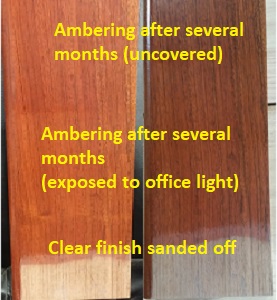All wood changes color over time depending on its environment, exposure to sunlight, and other factors, but sunlight has the biggest influence on wood - especially exotic wood species like Brazilian Cherry, Santos Mahogany, and Tigerwood. Domestic species like American Cherry, Walnut, Oaks, Maple and Hickory all amber as well but typically to as lesser degree than the exotic ones.
One comment we hear almost daily involves Brazilian Cherry (partly because it's by far the most popular exotic wood species we sell and partly because of the dramatic patina it develops over an incredibly short amount of time.)
Brazilian Cherry is infamous for its initial wide color variation. Depending on the lumber, it can range from a very light tan to a deep red and may even look like different wood species entirely. This is very common and mainly happens because of the way the rough lumber is stored (the boards on top will be exposed to sunlight while the middle boards will not). Once the treads are unboxed and exposed to the sun, they will begin to have a more uniform appearance very quickly. A quick way to check is place a tread or two near a window, in strong sunlight (indoors) for a day or two and then compare it to a tread kept out of the sun (for a good test. keep a different tread or two in a dark closet during this time).
You can also take a tread and tape a piece of paper on top as to create a shadow and then place the tread in direct sunlight. After a day or two, remove the paper and you should see an outline or reverse shadow where the paper blocked the sunlight.
While this happens with all wood given enough time, the exotic species seem to have the most dramatic change and largest range. Most of these woods look remarkably the same as rough lumber but once the outer layer is removed during processing and exposed to sunlight - the true beauty begins to shine.
Sometimes a photo is worth a thousand words, so we've prepared this little demonstration for you.

Two pictures of the same piece of Brazilian Cherry. Left is the original piece and right is after kept in the sun for several months
This is a Brazilian Cherry landing tread that was on a shelf in our office (not in direct sunlight). The part of the landing tread (upper section in the photo) was hanging off a shelf and thus saw a lot of indirect light, incandescent light etc. throughout the months and the bottom was hidden in the shadow of the shelf.
Notice how the upper part of the landing tread is darker than the lower part. To give a better demonstration of this, we sanded the clear finish and the top layer of the patinaed wood back down to bare wood to show how it had darkened over time.
After taking a photo, we took the piece of wood in the warehouse and left it near the door for a couple months to let it age more. Notice how the wood darkened significantly more and the raw, sanded section "greyed" over time.
If we were to sand the raw, uncoated section again, and remove the new patina layer, it would return to the much lighter brown shade in the photo to the left.
Remember - this wood had no stain on it whatsoever - just a clear top coat to give it the "shine". All color changes were completely natural and expected as a result of the sunlight and office light.
This is completely normal and happens all the time but, most of the time, the tread is uniformly exposed to sunlight so it ambers at the same rate. It all happens slowly enough for you not to notice during your day-to-day activities. This phenomenon is also noticed when an area rug is moved from a hardwood floor (most significantly noticed when the rug was near a window). There will be a much lighter "shadow" under the rug where the flooring around it ambered but the rug blocked the sunlight so the area immediately under the rug is lighter.
Since most people install their hardwood flooring first and the hardwood stair treads later, the flooring usually has a head start on the ambering process and is typically darker than the new treads when they first arrive. Don’t worry though - the treads will quickly darken at first, and then gradually slow down, matching your exotic flooring wonderfully. This can also happen from one particular piece of wood to another when they first arrive (and very freshly sanded and/or finished.)
The ambering process is completely normal, natural, and just one more reason that no two pieces of wood are exactly alike.
Keep this in mind when comparing our Brazilian Cherry or other exotic samples to you flooring or the fresh exotic stair treads you receive. Our samples have generally been sitting on a shelf for some time and already have a head-start on the ambering process but your new exotic wood stair treads were made only days before you receive them. Again, this process is completely normal and expected and does represent a defect or product issue.









Comments